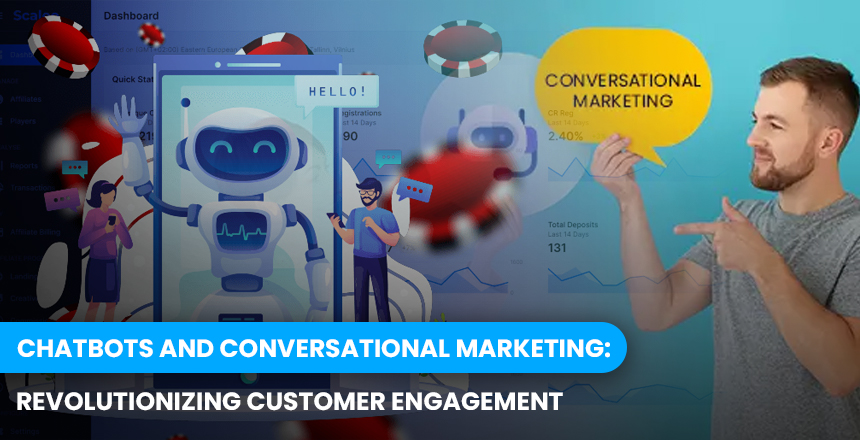In the current era of high-speed and high-tech digital living, the companies are consistently
trying to find new ways of engaging the audience’s engagement. The introduction of chatbots
and conversational marketing are the remarkable tools used that have changed how firms deal
with the customers. These newfangled devices have been the fusion of comfort, personal touch,
and quickness in operability thus making the customer experiences easily attained, their
resulting presence in marketing is a must. This blog will give an overview of the history of
chatbots, their parts in conversational marketing, and how they have spent worldwide.
The Rise of Chatbots in Modern Business
A chatbot is a tool using AI that is made to act like a human through conversations. They are
incorporated into websites, apps, and messaging platforms to handle customer queries, provide
information, and assist in various tasks.
A Brief History of Chatbots
The evolution of chatbots can be traced back to the year 1960 when a very simple natural
language processing program named ELIZA was invented. From that point on, chatbots have
come a long way with today’s variants using AI, machine learning, and natural language
processing (NLP) to decode and answer difficult questions. Currently, messaging applications
such as WhatsApp, Facebook Messenger, and Slack overflowing with chatbots, are pushing the
whole communication process to a new level of efficiency and accessibility.
Conversational Marketing: What Is It?
Conversational marketing is a customer-centric approach that uses real-time, one-on-one
conversations to engage customers. It is entirely different from the traditional marketing
methods which, generally, are based on static content or delayed responses since
conversational marketing allows for real-time communication and thus is more pedestrian.
Therefore, it is much more dynamic and, thanks to the immediacy of the responses, much more
personalized. Conversational marketing provides fast interchange, create a more attractive
journey for the customer.
Key Features of Conversational Marketing
- Real-time Communication: Promoting instant answers to clients’ questions.
- Personalization: Custom messages according to buyer conduct and inclinations.
- Omnichannel Presence: Harmonised communications throughout different channels.
Two-Way Interaction: Involving people in talks with customers more rather than just
communicating. Actual Communication instead of one-way.
How Chatbots Drive Conversational Marketing
The main focus of conversational marketing is chatbots. This is how they assist with making
good customer communication:
24/7 Availability
Living robots are the ones working in the bio-information technology field, operating 24/7 unlike
human agents. Even if a query comes at midnight or a weekend request, chatbots stay in touch
with customers, which in turn leads to their trust and satisfaction getting improved.
Chatbots for Visiting and Lead Qualification
Robots can chat with people visiting the website, take their information, and qualify leads
instantly. Through asking the relevant question, they are able to point out the potential
customers and redirect them to the sales team thus, lead generation would be much easier.
Personalized Recommendations
AI is being employed by chatbots as the technological tool that goes through customer data in
order to provide personalized recommendations of products or services. A practical example
would be an electronic commerce chatbot that has the capacity to suggest items that a
consumer might be interested in, by simply using the tools he/she has visited, thereby
maximizing cross-selling and upselling opportunities.
Instantaneous Customer Assistance
Chatbots are skilled in performing a variety of customer service jobs, ranging from replying to
frequently asked questions to troubleshooting problems. As a result, the average waiting time is
reduced, efficiency is raised, and human agents are left with the opportunity to solve more
challenging inquiries.
Enhancing the Customer Journey
Chatbots make sure customers are having a consistent and engaging experience by touching
on all the points of customers’ journeys such as awareness, consideration, purchase, and
post-purchase.
Chatbot Applications in Conversational Marketing That Are Most Common
Web stores and Retail:
They help chatbots to find the products, give an individual shopping experience, and manage
the order status.
Ex: Sephora’s Chatbot suggests beauty products and also helps in arranging appointments for
in-store shoppers.
Healthcare:
Chatbots offer health advice, assist in setting up appointments, and remind of medications to be
taken.
For instance, Babylon Health’s chatbot handles medical recommendations based on symptoms.
Finance:
Chatbots have been introduced to handle banking transactions like account inquiries and
provide budgeting tips while ensuring secure transactions.
As an example, Erica, the Bank of America chatbot, gives the user a hand in bill payments,
along with financial insights.
Hospitality and Travel:
Chatbots help customers book flights, check in online, and provide real-time travel updates.
Example: KLM Royal Dutch Airlines’ chatbot offers ticket booking and flight information on
Messenger.
Education:
Chatbots support online learning by answering course-related queries and providing study
resources.
Example: Duolingo’s chatbot offers conversational language practice.
Benefits of Chatbots and Conversational Marketing
Cost-Effectiveness
Chatbots reduce operational costs by automating repetitive tasks. They handle thousands of
inquiries simultaneously without requiring additional manpower.
Improved Customer Engagement
Real-time, personalized conversations foster deeper connections with customers, increasing
engagement and loyalty.
Scalability
Chatbots can handle an unlimited number of interactions, making them ideal for businesses of
all sizes.
Data Collection and Analysis
Chatbots collect valuable customer data during interactions, providing insights into preferences,
pain points, and behavior. This data helps businesses refine their marketing strategies.
Faster Sales Cycles
By providing instant answers and guiding customers through the purchasing process, chatbots
accelerate the sales cycle, boosting revenue.
Challenges in Implementing Chatbots and Conversational Marketing
While the benefits are significant, implementing chatbots and conversational marketing comes
with challenges:
Understanding Customer Intent:
Misinterpreting customer queries can lead to frustration. Continuous training of AI models is
essential to improve accuracy.
Balancing Automation with Human Interaction:
Over-reliance on chatbots can make interactions feel impersonal. Businesses must strike a
balance by involving human agents when necessary.
Data Privacy Concerns:
Collecting and storing customer data raises privacy issues. Businesses must adhere to data
protection regulations to maintain trust.
Technical Glitches:
Bugs or downtime in chatbot systems can disrupt customer experiences. Regular maintenance
and updates are crucial.
Future Trends in Chatbots and Conversational Marketing
As technology continues to evolve, the future of chatbots and conversational marketing looks
promising. Key trends include:
AI-Powered Conversational AI
Advanced AI algorithms will enable chatbots to understand and respond to complex queries with
human-like accuracy.
Voice Assistants
With the growing popularity of voice-enabled devices, chatbots integrated with voice technology
will become more prevalent.
Hyper-Personalization
Future chatbots will use predictive analytics to anticipate customer needs and deliver highly
tailored experiences.
Integration with IoT
Chatbots will connect with Internet of Things (IoT) devices to provide seamless interactions
across smart home systems and wearable technology.
Conclusion
AI bots, as well as conversational media, have drastically changed the nature of interaction
between businesses and their clients. They not only provide customers with real-time,
personalized, and efficient experiences but also acquire new users and grow sales.
Nevertheless, the organization needs to pay careful attention to planning, maintaining customer
goals as the priority, and respecting the data privacy laws for it to be successful.
The implementation of these technologies by law firms is only set to make chatbots a stronger
force in conversational marketing thus ushering.move to a time where everyone gets
personalized communication and real-time chat as standard features. The adaptability to this
change will work in the favor of firms for being one step ahead of their competition and also it
will help them develop long-term relationships with their clients.








